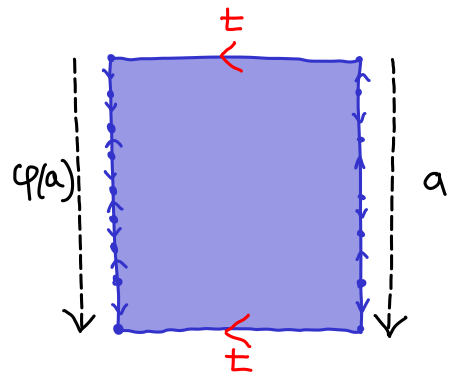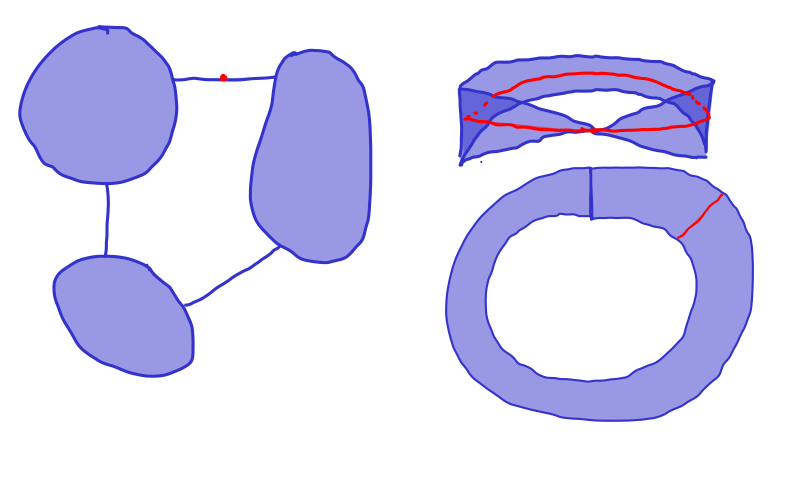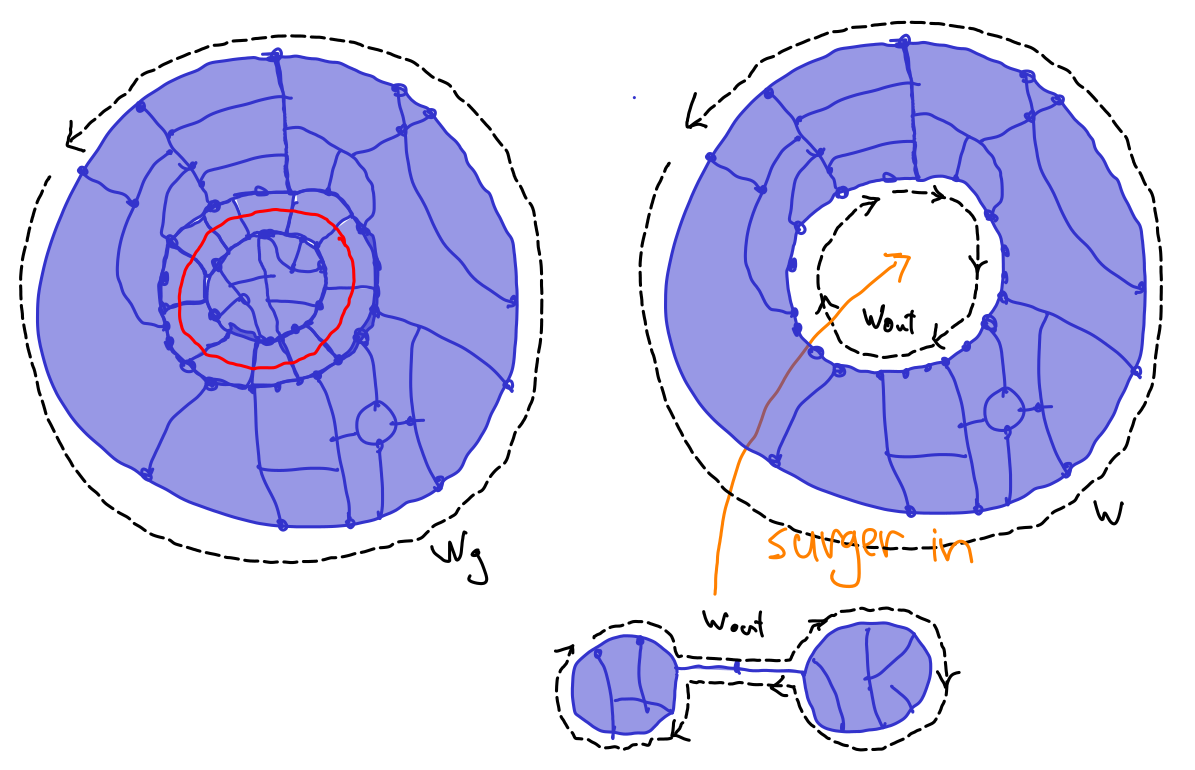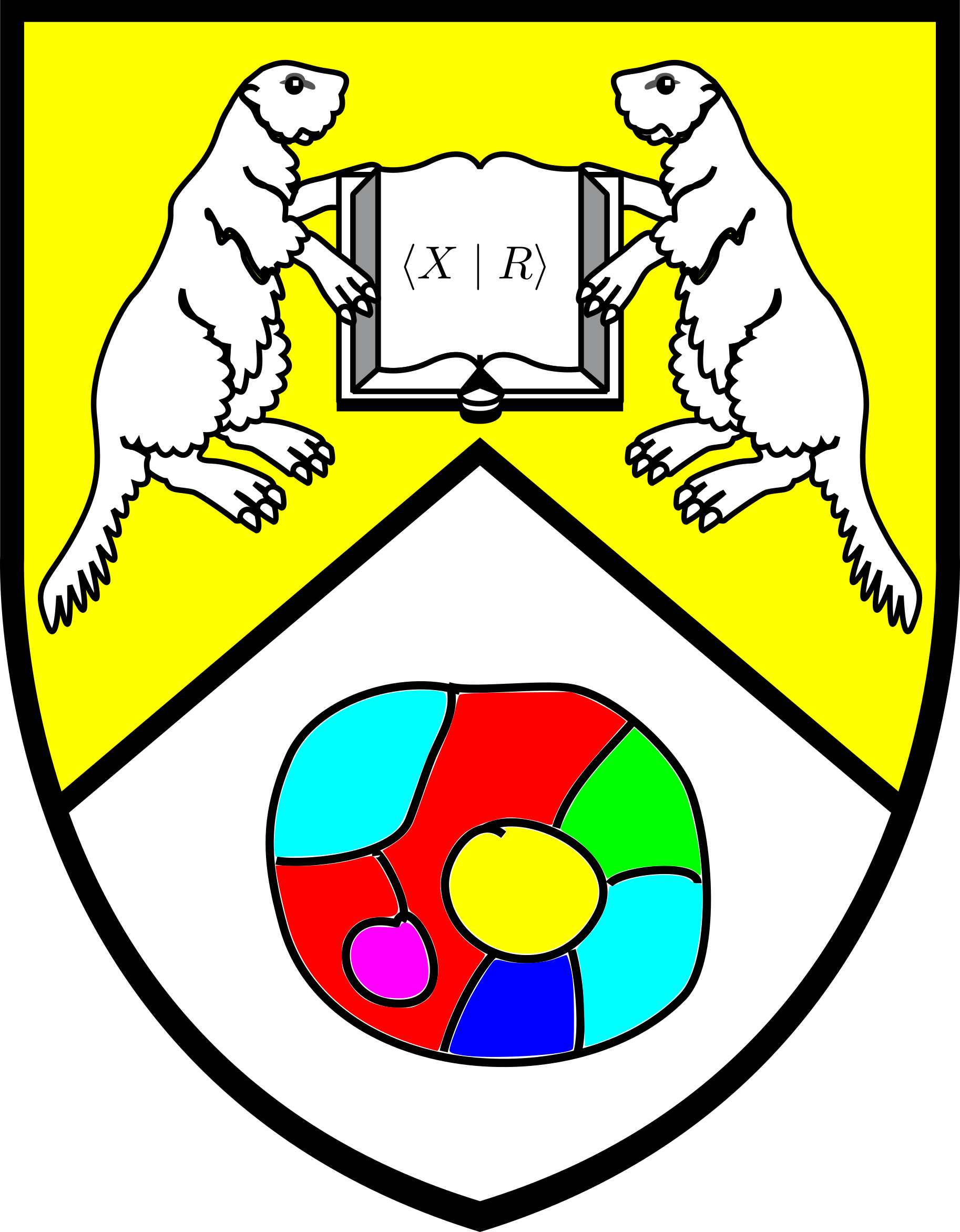Section 3.2 HNN extensions and dual tracks
In this lecture we will develop a method to understand the famous Baumslag-Solitar group
It worth stressing again that there is no general procedure which can take an arbitrary finite presentation \(\pres{x_1,\ldots,x_n}{r_1,\ldots,r_m}\) and will decide if this is a presenation of the trivial group.
For this reason, techniques to study groups from presentations are necessarily ad-hoc, and will only work in certain circumstances. We start with a construction in group theory
Subsection 3.2.1 HNN extensions
HNN extensions are named after mathematicians Higman, Neumann, and Neumann (the Neumanns were married.) They are formed by putting a group \(G\) inside a larger group \(G*_t\) with an extra generator called the stable letter, typically we use \(t\text{,}\) which conjugates elements in \(G\text{.}\) More precisely, suppose that \(G\) contains two subgroups \(A,A'\) such that \(A\approx
A'\text{,}\) i.e. \(A,A'\) are isomorphic and let \(\varphi:A\stackrel{\sim}{\to} A'\) be a specific isomorphism. See Figure 3.2.1.
i.e. we add a new generator \(t\) (we assume \(t \not\in X\)), the stable letter, and for each \(a \in A\) we add a relation which says that conjugation of an element of \(a\) by \(t\) produces the same result as making taking the image \(\varphi(a)\text{.}\) Incidentally we slightly changed the convention for relations: instead of writing \(t^{-1}at(\varphi(a)^{-1}\) we wrote \(t^{-1}at = \varphi(a)\text{,}\) which is equivalent. Also note that for these relations we actually mean that we wrote words in \(X^{\pm 1}\) represeting elements in \(a,\varphi(a)\in G\text{.}\) In particular we are not assuming \(A,A'\subset X\text{.}\)
Needless to say, adding extra relations to a group can have unexpected consequences. We want to show that \(G \leq G*_t\text{,}\) i.e. that \(G*_t\) is an extension of \(G\text{.}\) Note that by Lemma Lemma 1.6.1 there is a natural homomorphism \(G \into G*_t\text{.}\) Our first task is to show that this homomorphism is injective.
Subsection 3.2.2 Dual tracks and van Kampen diagrams
Comapring the presentation \(G=\pres X R\) and the presentation given in (3.2.1) we see that we have extra HNN relations which give rise to the following 2-cells:

Within each such 2-cell, we can draw a dual \(t\)-track which a segment in each HNN-2-cell joining the midpoints of the \(t\)-labeled edges. Within a van Kampen diagram, because the only place \(t\)-labelled edges occur is either as fully external edges, or inside HNN-2-cells, these segments join up to make dual \(t\)-tracks in van Kampen diagrams. 
This next lemma is a topological consequence of our requirements that van Kampen diagrams are planar and simply connected, that dual tracks are curves, and the Jordan curve theorem. One could probably also come up with a simpler purely combinatorial proof... but whatever, the lemma is completely obvious.
Lemma 3.2.4. The dual track lemma.
Dual tracks within a van Kampen diagram \(\mathcal D\) are either points, arcs with endpoints in the boundary of the diagram, or circles. Every track divides \(\mathcal D\) into two disjoint regions. Distinct tracks are disjoint.
We note that if a point type or an arc type track did not divide \(\mathcal D\) into two distinct components we would violate simple connectivity. If a circular track did not divide into two components we would have an embedded Möbius strip. 
This topologically flavoured lemma is the key to proving things about HNN extensions. We start with the following:
Theorem 3.2.6.
If \(G = \pres X R\) and we have an HNN extension
then \(G\) is naturally isomorphic to a subgroup of \(G*_t\text{.}\)
Proof.
Consider the two presentation. The inclusions \(X \into X\cup\{t\}\) and \(R \into R \cup\{t^{-1}w_at(w_{\varphi(a)})^{-1}\mid a \in A\}\text{,}\) where \(w_a,w_{\varphi(a)}\) are choices of words in \(X^{\pm 1}\) representing the elments \(a,\varphi(a)\) in \(G\text{,}\) induce by Lemma Lemma 1.6.1 a natural homomorphism \(\psi:G \to G*_t\text{.}\) We need to show that \(\psi\) is injective.
Suppose towards a contradiction that \(\psi\) was not injective. Then there is some \(g \in G\setminus\{1\}\text{,}\) of minimal word length, such that \(\varphi(g)\neq 1\text{.}\) By van Kampen's Lemma (Theorem 3.1.7) there is some reduced word \(w_g\) (realizing minimal word length) which is the boundary word of a van Kampen diagram \(\mathcal D\) whose 2-cells have boundary words from \(R \into R \cup\{t^{-1}w_at(w_{\varphi(a)})^{-1}\mid a \in A\}\text{.}\)
Because \(g \neq_G 1\text{,}\) \(\mathcal D\) cannot consist solely of 2-cells with boundaries from \(R\text{,}\) therefore \(\mathcal D\) must contain HNN-2-cells and therefore at least one dual \(t\)-tracks. Let \(\mathcal D\) such a diagram with a minimal number of tracks. Because the boundary word of \(\mathcal D\) is a word containing letters only in \(X\) none of the tracks can reach the boundary of \(\mathcal D\text{,}\) so they must all be cicrcles.
Let \(\tau \subset \mathcal D\) be an innermost circular track, i.e. it doesn't enclose any other circular tracks. The union of 2-cells containg it for an annulus \(\mathcal A\) with an inner boundary word \(w^{in}\) and an outer boundary word \(w^{out}\text{.}\) Now note on the one hand that, without loss of generality, \(w^{in}\) is a product of elements in \(A\) therefore \(w^{in} \in A\) and \(w^{out} = \varphi(w^{in})\text{.}\) On the other hand \(w^{in}\) is the boundary word of a van Kampen (sub) diagram, and since \(\tau\) is innermost there are no HNN-2-cells, so all 2-cells in the subdiagram have boundary labels in \(R\text{.}\) This means that \(w^{in} =_G 1\) and since \(\varphi A \to A'\) is an isomorphism we have that \(w^{out}=_G 1\) as well. Therefore by van Kampen's lemma we can find a van Kampen diagram \(\mathcal{D}'\)with 2-cells with boundary in \(R\) whose boundary word is \(w^{out}\text{.}\)

It follows that we can cut out the annulus \(\mathcal A\) and surgically re-attach \(\mathcal D'\text{.}\) The resulting van Kampen diagram is a witness of the triviality of \(w_g\) in
with one less track than \(\mathcal D\text{,}\) but this contradicts the fact that \(\mathcal D\) had a minimal number of tracks.
In fact, the main thrust of the proof of the previous Theorem can be restated as the following lemma:
Lemma 3.2.8.
Among all van Kampen diagrams witnessing the triviality of a word in an HNN extension, a diagram \(\mathcal D\) with a minimal number of dual \(t\)-tracks will not contain any circlar tracks.
Next we have this other injectivity result for the mapping \(\ZZ \to \gen t\text{:}\)
Proposition 3.2.9.
Let \(G*_t\) be an HNN extension with stable letter \(t\text{,}\) then the element \(t\) has infinite order in \(G*_t\text{.}\)Proof.
Suppsose towards a contradiction that \(t^n=1\) form some \(n>0\text{.}\) Then \(t^n\) is the boundary word of a van Kampen diagram \(\mathcal D\text{.}\) This means that there are tracks starting and ending on the boundary of \(\mathcal D\text{,}\) but since the 2-cells containing containing tracks are HNN-2-cells, Figure 3.2.10 below shows that any such track \(\tau\) must lie in a "twisted strip". 
This contradicts the planarity of \(\mathcal D\text{,}\) or the fact that \(\tau\) cuts \(\mathcal D\) into two components.
Subsection 3.2.3 Economical presentations and (some of) the secrets of \(\mathrm{BS}(1,2)\)
The presentation (3.2.1) for \(G*_t\) may have infinitely many relators, one for each element in \(A\text{.}\) Until now, this infinite presentation has been convenient, but seeing as we are primarily interested in finitely presented groups, it will be nice to get a criterion for when an HNN extension is also finitely presented.
Proposition 3.2.11.
Suppose that the associated subgroup \(A,A' \leq G\) are finitely generated and that \(G=\pres X R\) is finitely presented. Then the HNN extension \(G*_t\) is finitely presentable as
where \(\{a_1,\ldots a_n\}\) are words in \(X^{\pm 1}\) representing a finite generating set for \(A\) and the \(a_i'\) are words satisfying \(\varphi(a_i) = _G a_i'\text{.}\)
So now let's turn our attention to the following little presentation:
Let's show that it is an HNN extension.
We first note that \(\ZZ \approx \pres{a}{}\text{.}\) Now \(\pres{a}{}\) contains the subgroups \(\gen a\text{,}\) i.e. the whole thing, and \(\gen{a^2}\text{,}\) i.e. \(2\ZZ\text{.}\) Both of these subgroups are isomorphic to \(\ZZ\) and we can take the isomorphism:
Recall that a homomorphism is fully determined by the image of a generating set.
Therefore \(\mathrm{BS}(1,2)\) is an HNN extension of the cyclic group. In particular we have an injective homomorphisms
so \(a\) has infinite order in \(\mathrm{BS}(1,2)\text{.}\) This fact was what was missing in Example 2.2.7. Now we have proved the existence of a group that is "algebraically" embedded into another group, but such that the inclusion is not a quasi isometric embedding.
Actually, the simplest examples of distorted subrgroups (i.e. subgroups that are not quasi isometrically embedded) arise from HNN extensions.
Similarly, we see that the other Baumslag-Solitar groups
are also infinite and the element \(a\) has infinite order. Note that here although we used the letter \(b\) instead of \(t\text{,}\) we still have the HNN extensions structure.
Subsection 3.2.4 Syllables and Britton's lemma.
Our treatment of HNN extensions, using van Kampen diagrams and tracks, is not historical. In this final section we will give some classical notation and the main classical result regarding HNN extensions.
Suppose that we are given \(G = \pres X R\) then every element in \(G*_t\) can be represented as a word of the form
where the subwords \(a_i\) are words in \(X^{\pm 1}\text{,}\) \(t\) is the stable letter, and the \(n_i \in \ZZ\text{.}\) The words \(a_i\) are called \(G\)-syllables.
If we are more explicit and identify \(A,A' \leq G\) and \(\varphi:A \to A'\) so that \(\varphi(a) = t^{-1}at; a \in A\) then we say that a word \(w\) can be pinched if it contains a subword
where \(a_i \in A'\) or \(a_j \in A\text{.}\) In this case we can reduce the numner of occurrences of \(t\) via
For this reason we will say that a word in an HNN extension is reduced if it doesn't contain any pinches. We now finish by stating what is the classical fundamental theorem of HNN extensions:
Theorem 3.2.12. Britton's Lemma.
If a word \(w\)in an HNN extension \(>G*_t\) represents the trivial element, then either it is a word in \(X^{\pm 1}\) representing the trivial element in \(G\) or it can be pinched.
In particular reduced words in HNN extensions are non-trivial. At this point there is enough machinery so that an interested reader could consult Chapter 9 of [6] to see how to contruct a group with undecidable word problem.
Exercises 3.2.5 Exercises
1.
Consider \(\ZZ = \gen a\text{.}\) \(\gen a\) has two automorphisms, the identity automorphism and the automorphism perscribed by \(a \mapsto a^{-1}\text{.}\)
- Identify the group you get when you use the identity automorhpism. I assure you, you know this group.
- Show that the group \(G'\)obtained by forming a HNN extension using the non-trivial automorphism of \(\ZZ\) is not isomorphic to the group you found previously.
- Give a critique of the notation \(G*_t\) used to denote an HNN extension.
2.
Prove Proposition 3.2.11.
Hint: Start by showing that for each of the (possibly infinitely many) old HNN-2-cells, you can construct a van Kampen diagram with the same boundary word using your finite set of relations. Use this and van Kampen's Lemma to apply Lemma 1.6.1 in order to get an isomorphism between the two groups corresponding to the finite and infinite presentation.
3.
Prove Britton's Lemma (Theorem 3.2.12)
Hint: Draw a van Kampen diagram. Seriously, MAKE A DRAWING. Explain why you can assume there are no circular tracks. Find an "outermost" track and show that the piece of the boundary word travelling between the endpoints of the outermost track must lie in one of the associated subgroups.
4.
Take the free group \(F_3 = F(a,b,c)\) and find two isomorphic subgroups \(H,H'\) of rank at least 4.- Give an isomorphism between \(H,H'\) and write out the full presentation of the corresponding HNN extension \(G = (F_3*_t)\)
- Referring to results of the previous chapters, give a convincing explanation of how to solve the word problem in this group.
Hint: Subgroup membership and pinching.
